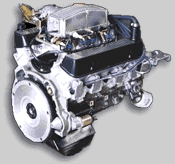Overview.  |
The injection systems for The Rover Engine have
evolved quite dramatically over the past 20 years and fall into
the following three major categories. (I will add the Third Gems
information soon) although you can find some further information
on 'Gems' in our
project pages here and bigger engine upgrades for the 4.0 and 4.6 HSE here.
Don't forget to use your Browser Back Button to return.
Flapper Type
Mainly used in the early 80s, this system is the earliest
and has a few major drawbacks. First, the system, due to age,
is normally found with poor condition injectors, air flow meter
and fuel regulator, and there is little point in adding it to
your engine in favour of, say, a Weber, as the cost will escalate
when these parts are replaced with new. However, if you already
have the Flapper type injection, then it can be made to work really
well when all its problems have been fully addressed.
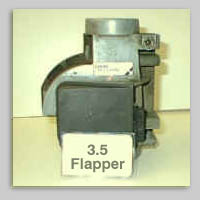 |
Here you can see the Air Flow meter of the Flapper type injection system. Unlike the later systems it is a mechanical device that suffers from poor signal quality when the inner carbon track is worn, and unlike the later Air Mass Meter as used on Hot wire injection, it is only able to give information relating to air speed.
It has no ability to give the ECU, air density or temperature
information.
Reconditioned units are available from us œPOA exchange.
Unfortunately none available at the moment.
|
Improving things |
The failings of this system can largely be overcome with a
fitment of the Adjustable (Rising Rate) fuel pressure regulator.
But beware, with age, most will still be wanting due to the
injectors, and will have poor injector pressure and spray
pattern. They may also need replacing to make it all work
as it should.
Recon. injectors are available œPOA, exchange.
Vehicles such as Pre-90s Morgans, SD1s, TVRs etc. or pre-90s Range/Land Rovers converted to bigger capacity or requiring even higher engine performance, should consider having the ECU re-mapped to compliment the upgrade completely.
The
Efi power boost valve!  |
The success of this product can be reproduced on almost all Fuel injected engines for all makes of vehicle. Please enquire for availability for your car.
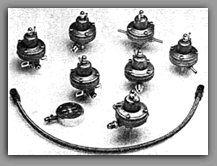 |
Instant throttle
response |
| Removal of
performance flat spots |
| Extra engine
performance |
| Faster acceleration
|
|
This refined fuel regulator enhances engine
performance and acceleration by accelerating
enrichment of the fuel mixture under load.
The power boost valve is simple to install and
in most instances, basic fitting instructions
are provided. These units are mechanical and
are considered maintenance free.
This upgrade is simple to understand
when appreciating manufacturers' needs to build
an engine that will operate in all extremes.
Perhaps the highest of altitudes or the lowest
of temperatures. The power boost valve will
also help overcome the inherent restrictions
of this early type system.
How does the Efi power boost valve work?
The power boost valve is a high performance tuning part which replaces the original equipment valve (fitted to the vehicle). The benefits are outlined below by drawing a comparison evaluation:
Rising Rate.
The electric fuel pump supplies fuel at a high pressure to the fuel rail and injectors which is then regulated by a fuel pressure control valve. Typically, the regulator is not adjustable and is pre-set to 3 bar maximum pressure. At idle the fuel pressure valve reduces it by 0.5 bar approx. to 2.5 bar. When accelerating quickly from standstill the fuel pressure increases at a proportional rate, retaining a lean fuel mixture strength as required by the EEC for new vehicles. However, the resultant effects of the standard valve produce:
A. Lethargic throttle response
B. Occasional drivability problems at slow traffic speeds
C. Intermediate performance 'flat spots' when accelerating
By comparison: Power Boost Valve (Replacement) Control of Base Fuel pressure
First, this valve has an adjustable fuel
pressure affected by the movement of an
adjustable screw on the crown of the unit.
New power boost valves are pre-set with a maximum fuel pressure of 2.5, 3.0 or 3.5 bar, depending on the vehicle in question, and similarly (to the original valve) the fuel pressure is reduced by 0.5 bar approx. at idle.
There the similarities end.
On acceleration from standstill the power boost valve fuel pressure will increase at 1.7 times the standard rate. This will produce a healthy, strong fuel mixture strength which will instantly improve the drivability of your vehicle.
Available for all Fuel Injected, standard, tuned or competition engines. |
| Standard System -
Only |
œPOA |
| Hot-wire System -
Only |
œPOA |
|
|
V8 Fuel Injectors. |
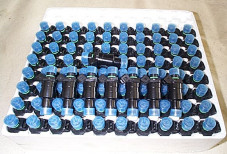
At last
Now Back in Stock |
Shown with protective caps fitted
Brand new 3.9, 4.0 4.2 and 4.6 Injectors, less than 1/2 list price. One of the main reasons for poor fuel consumption on all 3.9, 4.0 and 4.6 models. œPOA (you change you plugs every 6 or 12000m, when did you last change your injectors?) for a set of 8, these have to be the best value anywhere.
(recon. Injectors also available) |
| |
|
Although this page contains no ECU re-mapping information for the Flapper type
injection system, it is achieveable with our new Evo 4 computer upgrade, please
enquire.
Customer comments  |
(Range Rover 3.5 to 4.6 conversion)
Dear Chris, I've been to Power Engineering in Uxbridge today, to say my car has been transformed is a massive understatement. Both Mark and Merv (of Power Engineering) were most helpful, their understanding of things electrical, and ability to put this in 'laymans' terms is wonderful. For any prospective purchasers of your 4.6 conversion - if keeping the old flapper type injection system - I cannot stress how much more drivable this ECU conversion makes the engine. It was a joy to drive home today - so smooth and was just what I imagined the conversion to be like.
Update From Alan. Just a short note to let you know that the Jaguar Extra Air valve solved the idling problem - the car fired up fine and ran as though it had choke on this morning - first time ever!
The Range Rover air valve seemed to be working okay - it just didn't give enough air flow to the engine when cold so I'd advise this mod for any flapper type system. Especially if the engine has increased capacity. I picked the part up for £30 (second hand) and can supply the part number if you're interested. I still feel the car is very rich on tickover - so I'll still see Mark to try some minor electrical mods....
Identifying your Injection type |
There are basically three types of production Rover V8 Injection systems with
some variations., this section is designed to help you decide what injection
system you have, so we can advise on the best upgrade for you.
The Above information and details all relate to the earlier 'Flapper Type' Injection system.
 |
Which one is yours?
If you are a little concerned about what type of injection system you have, identifying the Air flow/Mass Meter will determine it for you. This applies to all EFI V8s except the later 4.0 and 4.6 models. These use the later 'Gems' Engine management. |
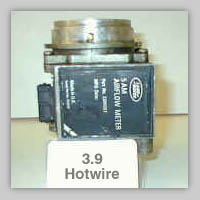 |
Tuning
Tips |
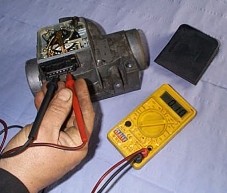 |
When checking the 'Air flow meter', you are likely to find erratic resistance readings.
This is a sure sign that it needs replacing. Because
of age, not many original units will be in good order,
and will be an issue for all those V8 engines with injection
components this old.
Another sign of a worn out AFM is that when adjusting,
it makes no changes to engine performance or CO emissions. |
| |
|
Adjustable (Rising rate) fuel
pressure regulator. New or reconditioned injectors and a reconditioned
Air flow meter should be the minimum considered requirements
when seriously upgrading any Rover V8 (Flapper) Injection
system. Especially if you are expecting the best of results
from your setup. A reprogrammed ECU, is an 'even better upgrade'
and must be considered 'Icing on the Cake' |
|











